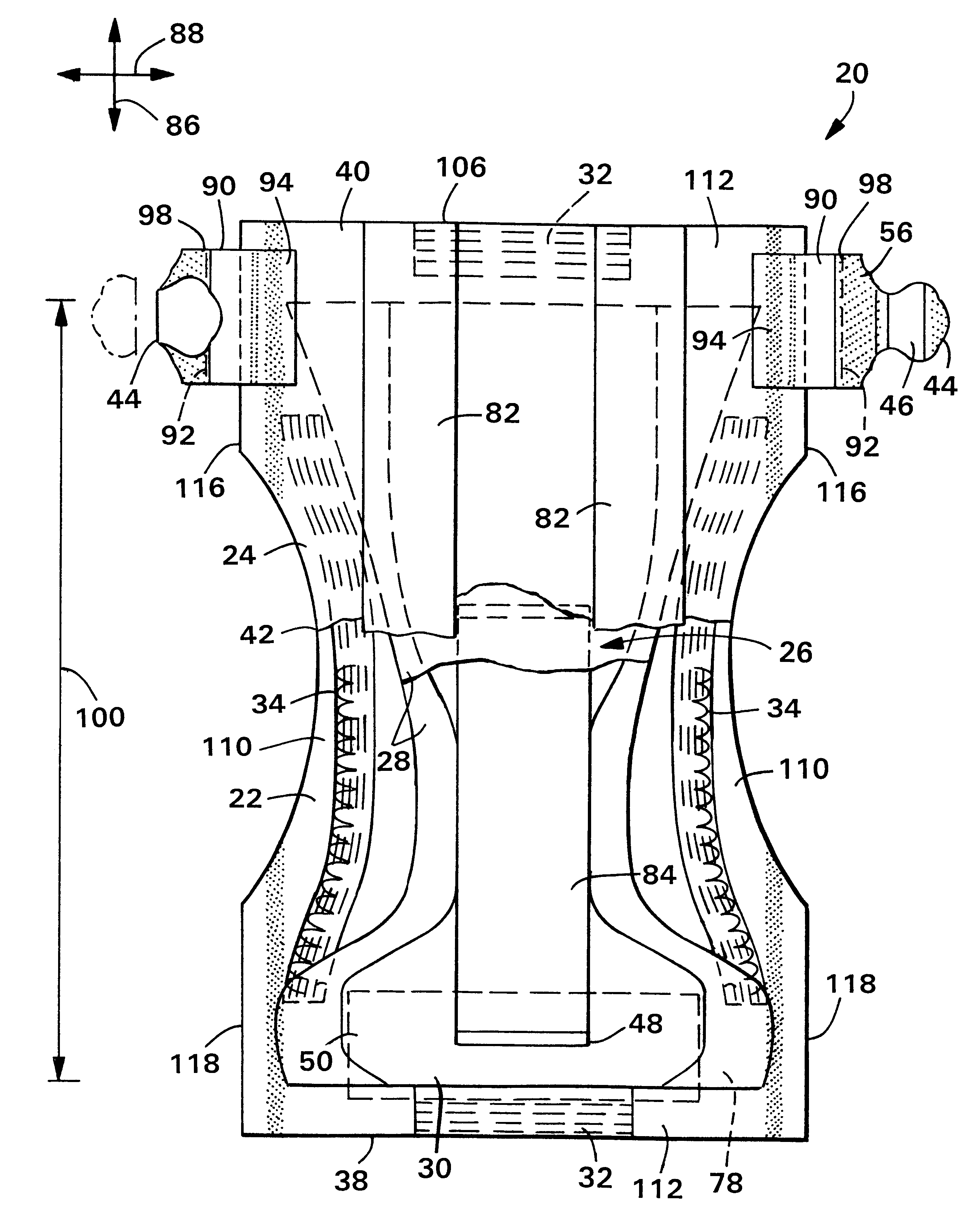Layered absorbent structure
a technology of absorbent articles and layers, applied in the field of absorbent articles disposable, can solve the problems of inability of the absorbent core to fully absorb liquids quickly and completely, frequent leakage of absorbent articles, and inability to fully absorb liquids
- Summary
- Abstract
- Description
- Claims
- Application Information
AI Technical Summary
Problems solved by technology
Method used
Image
Examples
example 1
The upper layer is at a basis weight of 400 gsm and is composed of 20% 53C superabsorbent, a superabsorbent available from Dow Chemical, and 80% HPF2 mercerized pulp, a material available from Buckeye Corp. The Dow 53C superabsorbent has a .tau. of 8.5 minutes; a FAUZL capacity of 33 g / g; and a 0.3 psi MAUL value of 26.2 g / g. The upper layer extends over the area of the layer region 48 shown in FIG. 2, and is densified to 0.2 g / cc.
The lower layer is at a basis weight of 450 gsm and is composed of 40% SXM 880 superabsorbent, a superabsorbent material available from Stockhausen, and 60% CR-1654 fluff pulp, available from Alliance Forest Products, a company located in Coosa Pines, Ala. The SXM 880 superabsorbent has a .tau. of 4 minutes; a FAUZL capacity of 38 g / g; and a 0.3 psi MAUL value of 29.8 g / g. The lower layer extends over the entire area of the absorbent system (the area of layer region 50), as shown in FIG. 2, and is densified to 0.2 g / cc.
This example has a Flow Conductance V...
example 2
The upper layer is at a basis weight of 400 gsm and is composed of 20% 53C superabsorbent, a superabsorbent available from Dow Chemical, 5% Type 255 binder fiber, available from Hoechst Celanese Corporation, and 75% HPF2 pulp, available from Buckeye Cellulose Co. The Dow 53C superabsorbent has a .tau. of 8.5 minutes; a FAUZL capacity of 33 g / g; and a 0.3 psi MAUL value of 26.2 g / g. The material was produced at a density of 0.05 g / cc and densified for use in the product to 0.2 g / cc under conditions which would not result in the remelting and bonding of the binder fiber. This material was shaped as shown in FIG. 2.
The lower layer is at a basis weight of 450 gsm and is composed of 40% SXM 880 superabsorbent, a superabsorbent material available from Stockhausen, and 60% CR-1654 fluff pulp, available from Alliance Forest Products, a company located in Coosa Pines, Ala. The SXM 880 superabsorbent has a .tau. of 4 minutes; a FAUZL capacity of 38 g / g; and a 0.3 psi MAUL value of 29.8 g / g. T...
example 3
The upper layer has a basis weight of 350 gsm and is composed of 40% 53C superabsorbent, a superabsorbent available from Dow Chemical and 60% HPF2 fluff pulp, available from Buckeye Cellulose Co. The Dow 53C superabsorbent has a .tau. of 8.5 minutes; a FAUZL capacity of 33 g / g; and a 0.3 psi MAUL value of 26.2 g / g. The material is utilized in the shape of the layer 48, as described in FIG. 2, and has a density of 0.2 g / cc.
The lower layer is at a basis weight of 450 gsm and is composed of 40% SXM 880 superabsorbent, a superabsorbent material available from Stockhausen, and 60% CR-1654 fluff pulp, available from Alliance Forest Products, a company located in Coosa Pines, Ala. The SXM 880 superabsorbent has a .tau. of 4 minutes; a FAUZL capacity of 38 g / g; and a 0.3 psi MAUL value of 29.8 g / g. The lower layer extends over the entire area of the absorbent system (the area of layer 50) as shown in FIG. 2 and is densified to 0.2 g / cc.
This example has a Flow Conductance Value of 4.05.times...
PUM
| Property | Measurement | Unit |
|---|---|---|
| thickness | aaaaa | aaaaa |
| thickness | aaaaa | aaaaa |
| width | aaaaa | aaaaa |
Abstract
Description
Claims
Application Information
 Login to View More
Login to View More - R&D
- Intellectual Property
- Life Sciences
- Materials
- Tech Scout
- Unparalleled Data Quality
- Higher Quality Content
- 60% Fewer Hallucinations
Browse by: Latest US Patents, China's latest patents, Technical Efficacy Thesaurus, Application Domain, Technology Topic, Popular Technical Reports.
© 2025 PatSnap. All rights reserved.Legal|Privacy policy|Modern Slavery Act Transparency Statement|Sitemap|About US| Contact US: help@patsnap.com



